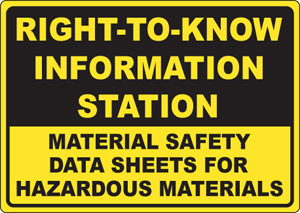Posts Tagged ‘Right to Know’
“Scant Oversight and Lax Reporting” Doom Federal Right-to-Know Regs
 Reuters examines the almost 30-year old Emergency Planning and Community Right to Know Act and finds that, depending on what state you live in, the information that's supposed to be provided to the public is either semi-correct, or full of holes you can drive tanker trucks through.
Reuters examines the almost 30-year old Emergency Planning and Community Right to Know Act and finds that, depending on what state you live in, the information that's supposed to be provided to the public is either semi-correct, or full of holes you can drive tanker trucks through.
One of the provisions of the Act is supposed to be an annual inventory of all hazardous chemicals on site at a particular facility. Some 500,000 different substances are covered under the regs and should be accounted for…
But facilities across the country often misidentify these chemicals or their location, and sometimes fail to report the existence of the substances altogether. And except for a handful of states, neither federal nor local authorities are auditing the reports for errors.
As was demonstrated in West, recently, it's important to know what hazardous materials are stored where and in what quantity. Not only for the sake of surrounding residents, but for the first responders coming to their aid in any kind of accident or incident. Reuters cites several examples where firefighters showed-up and were injured on the scene when they didn't know a hazardous chemical was on-site.
A recent Congressional study estimated 60 deaths, more than 1,300 injuries and more than $1.6 billion in onsite and off-site damages caused by accidents at facilities storing 140 Tier II chemicals that have been deemed most dangerous by the EPA.
These numbers also don't include accidents at oil and gas industry sites, often exempt from the same reporting requirements as other industries. It's another reason why Dallas should include a complete, water-proof disclosure provision in any new gas drilling ordinance its Council passes.
Groups Petition EPA to Include Frackers in Toxic Release Inventory
 A dozen environmental and citizens groups filed a petition with EPA on Wednesday to close a loophole in the law and include oil and gas pollution in the annual system of self-reporting emissions and releases with which most US industrial polluters already have to comply.
A dozen environmental and citizens groups filed a petition with EPA on Wednesday to close a loophole in the law and include oil and gas pollution in the annual system of self-reporting emissions and releases with which most US industrial polluters already have to comply.
The Toxic Release Inventory, or TRI, was created in the wake of the horrible Union Carbide plant accident in Bhopal, India, that killed 2500 people immediately, and caused another 16,000 deaths in the months and years since. It's supposed to keep track of all hazardous and toxic chemicals on-site or released by industry at every facility regulated – power plants, cement plants, refineries, chemical plants of all kinds, lead smelters, etc. TRI numbers are self-reported once a year by the companies operating the facilities, based on EPA formulas. These numbers are then made available to the public via the EPA's own TRI Explorer site, or independent groups like RTK.net run by the OMB Watch folks.
However, the TRI leaves out a very large industrial segment – oil and gas drilling. This exemption might have made some sense 30 years ago, but it doesn't now, especially given the dramatic rise in modern-day fracking techniques that use large volumes of hazardous and toxic materials.
If EPA regulators went along, that would fold in not just drilling but also related activities at the wellhead, before oil and gas is ready for transport to customers and refiners. Under environmentalists’ petition, companies would be forced to report chemicals released in drilling and completing wells as well as compression operations and processing at fractionators that split gas into separate components.
Disclosures also would be required from hydraulic fracturing operations, in which mixtures of water, sand and chemicals are pumped underground to release natural gas and oil from dense rock formations.
Eric Schaeffer, director of the Environmental Integrity Project that spearheaded the campaign, stressed that the foundation of the TRI was a deeply held belief that the public has a right to know what kind of pollutants are being released from neighboring facilities.
We’re asking the EPA to “honor those values,” Schaeffer said. “EPA has the power to add other sectors that ought to be reporting, and we’re asking them today to exercise the authority.”
Jane Davenport, a senior attorney with the Delaware Riverkeeper Network, said the reporting mandate should apply broadly.
“The oil and gas industry should not get a pass from statutes that apply to other industries,” she said, noting that the industry already enjoys some exemptions from provisions in the Clean Water Act and other environmental laws.
This may not sound like a radical step, but don't discount the power of public disclosure. TRI numbers from the Midlothian cement plant helped Downwiders show that the kilns were the largest industrial and toxic polluters in North Texas, proved the companies were not telling the truth when they said there were no toxic emissions from waste-burning or cement-making, and allowed citizens to track the volumes of pollution coming out of the kilns and analyze those numbers for trends. That's why the oil and gas industry will be fighting tooth and nail to keep the loophole open. Even something as innocuous as disclosing your own chemical information is threatening to operations that have enjoyed historic protections from the public spotlight.
